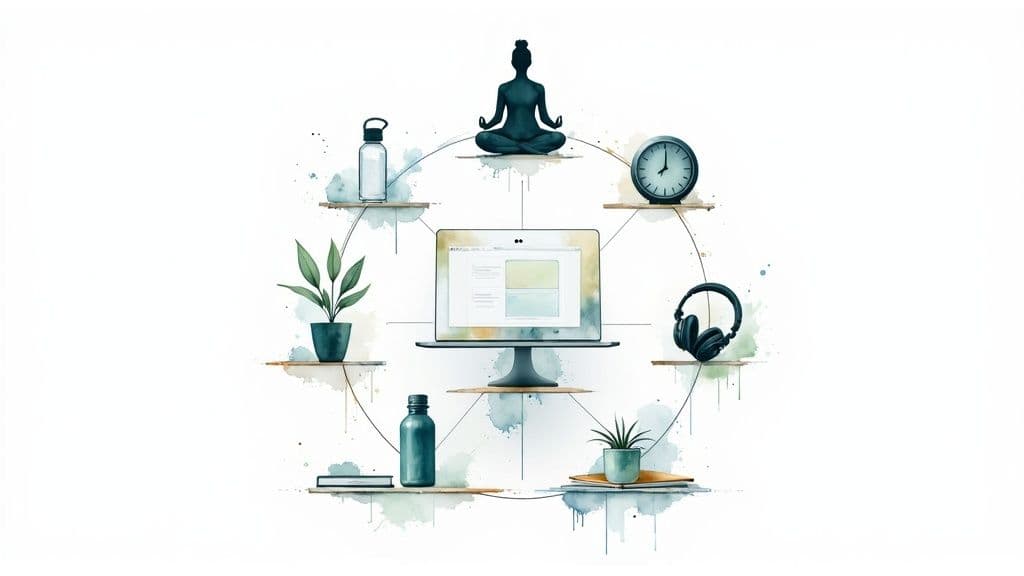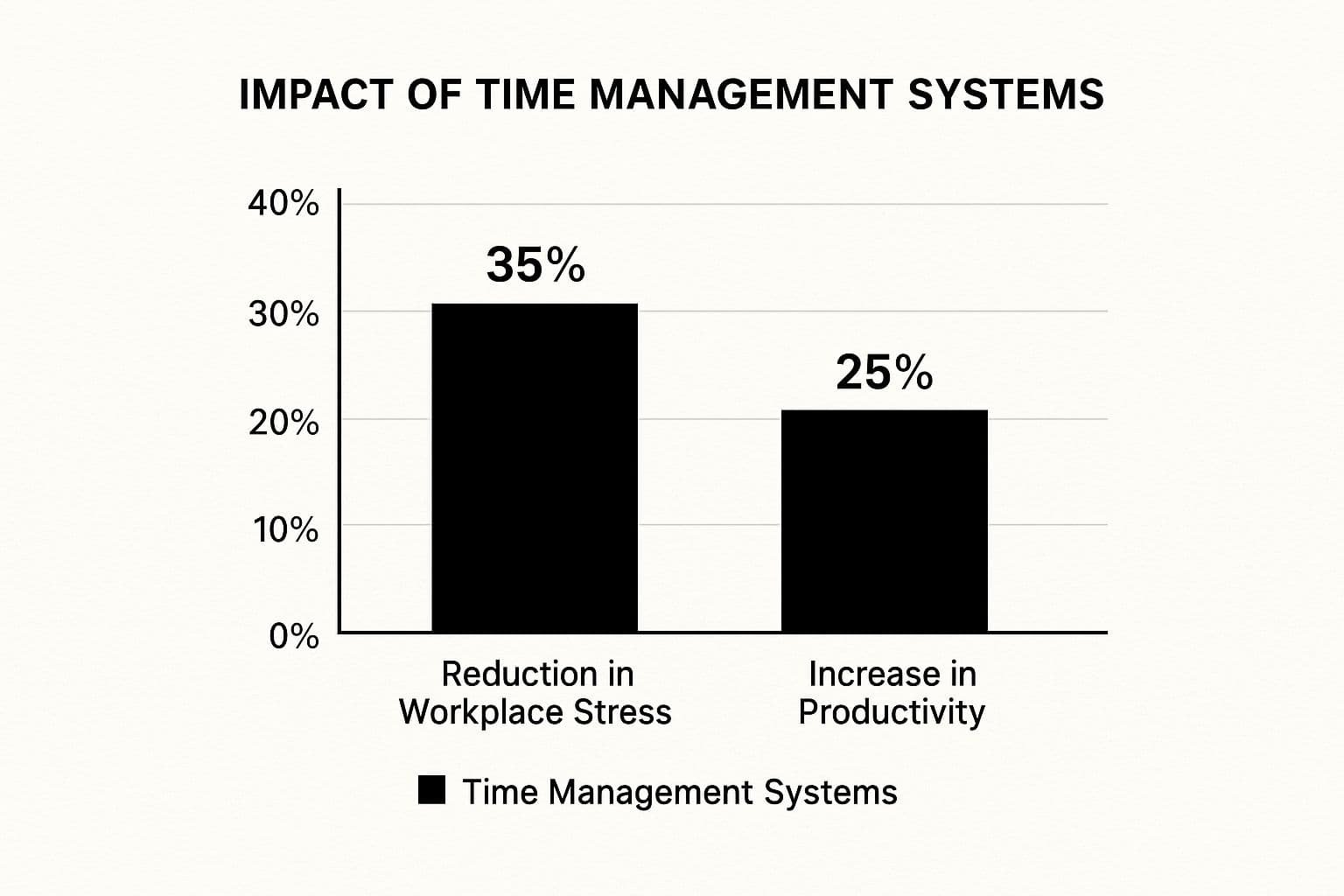Discover effective workplace stress reduction strategies to improve your well-being and productivity in 2025. Click for practical tips!
July 23, 2025 (4mo ago)
Top 8 Workplace Stress Reduction Tips for 2025
Discover effective workplace stress reduction strategies to improve your well-being and productivity in 2025. Click for practical tips!
← Back to blog
In today's fast-paced, always-on work culture, the pressure to perform can feel relentless. The line between professional ambition and personal burnout is becoming increasingly thin, making effective workplace stress reduction not just a wellness trend, but a critical business imperative. Chronic stress doesn't just impact individual well-being; it actively erodes productivity, stifles creativity, and drives employee turnover. The modern professional’s challenge lies in moving beyond generic advice to adopt specific, actionable strategies that create real, sustainable change in their daily routines.
This article cuts through the noise to provide a detailed roundup of eight proven methods that you can implement immediately. We will explore a range of powerful techniques for workplace stress reduction**, from advanced cognitive reframing and strategic boundary-setting to dynamic time management systems. For each strategy, we will provide concrete steps and practical examples. We'll also highlight how intelligent task management platforms like Fluidwave can amplify these methods, helping you reclaim control over your schedule, enhance your focus, and build a more resilient and sustainable professional life. You will leave with a clear roadmap for transforming how you manage pressure and approach your work.
1. Deep Breathing and Breathing Exercises
Controlled, deep breathing is a cornerstone of mindfulness-based stress reduction, offering a powerful, immediate method to calm your body’s physiological stress response. This technique involves intentional, slow breathing patterns that activate the parasympathetic nervous system, effectively telling your brain and body it's time to relax. The result is a lower heart rate, reduced blood pressure, and decreased levels of the stress hormone cortisol, making it an essential tool for effective workplace stress reduction.

This isn't just theory; it's a proven practice. Tech giants like Google incorporate breathing exercises into their 'Search Inside Yourself' leadership program. Similarly, healthcare professionals often use the 4-7-8 breathing technique between demanding patient visits to reset their focus and manage emotional strain. Even high-stakes financial traders utilize box breathing to maintain composure before critical market calls.
How to Implement Breathing Exercises at Work
Integrating this practice into your workday is simple and requires no special equipment. Use these techniques before a high-pressure meeting, after a difficult conversation, or anytime you feel overwhelmed.
- Practice the 4-7-8 Technique: Popularized by Dr. Andrew Weil, this method is highly effective. Inhale quietly through your nose for a count of 4, hold your breath for a count of 7, and exhale completely through your mouth for a count of 8.
- Try Box Breathing: Used by Navy SEALs for focus under pressure, this involves inhaling for 4 seconds, holding for 4, exhaling for 4, and holding again for 4. Repeat this cycle for several minutes.
- Schedule Breathing Breaks: Set a recurring reminder on your phone or calendar to pause for a two-minute breathing session every couple of hours. This proactive approach prevents stress from accumulating throughout the day.
- Create a Ritual: Before joining a video conference or starting a complex task, take one minute to close your eyes and focus on your breath. This small ritual acts as a mental buffer, preparing you to engage with clarity and calm.
For a guided experience, see the video below which demonstrates a simple breathing exercise you can do right at your desk.
2. Time Management and Prioritization Systems
Structured time management and prioritization systems offer a systematic approach to organizing tasks, managing deadlines, and clarifying responsibilities. Adopting these frameworks provides a clear roadmap for your workload, which is crucial for effective workplace stress reduction. By creating order out of chaos, these systems empower you to regain control, reduce the anxiety tied to competing demands, and prevent the feeling of being constantly overwhelmed.
The impact of structured work systems is significant. The minimalist bar chart below visualizes key data from recent productivity studies, showing the tangible benefits of adopting these methods.

This data highlights a clear correlation: implementing a formal time management system not only boosts output but also leads to a substantial decrease in perceived stress levels. This proves that feeling in control of your time is a direct path to a calmer, more productive work life.
How to Implement Time Management Systems at Work
Integrating a prioritization framework into your daily routine can transform how you approach your responsibilities. Use these methods to bring clarity and focus to your workday, especially when facing a heavy workload or tight deadlines.
- Use the Eisenhower Matrix: Divide tasks into four quadrants: Urgent & Important (Do now), Important & Not Urgent (Schedule), Urgent & Not Important (Delegate), and Neither (Eliminate). This clarifies what truly deserves your immediate attention.
- Implement Getting Things Done (GTD): Popularized by David Allen, this method involves capturing all tasks in an external system, clarifying what they are, and organizing them by context. This frees up mental bandwidth by getting to-dos out of your head.
- Try the Pomodoro Technique: Work in focused 25-minute intervals separated by short breaks. This technique, developed by Francesco Cirillo, combats mental fatigue and improves concentration on single tasks.
- Block Time in Your Calendar: Go beyond scheduling meetings. Block specific times for deep work, responding to emails, and administrative tasks. This protects your focus and ensures progress on important projects.
- Conduct a Weekly Review: Set aside 30 minutes each week to review your accomplishments, assess upcoming priorities, and adjust your plan. This ritual keeps you aligned with your long-term goals and prevents last-minute scrambles. For more detailed techniques, you can explore these advanced time management strategies on fluidwave.com.
3. Workplace Meditation and Mindfulness Programs
Structured meditation and mindfulness programs are a powerful strategy for workplace stress reduction, moving beyond simple relaxation to build lasting mental resilience. These practices, which include guided meditation, mindful awareness, and body scan techniques, train employees to observe their thoughts and feelings without judgment. This develops greater emotional regulation, reduces reactivity to stressors, and enhances focus, enabling individuals to navigate the pressures of work with a calm and centered mindset.
The effectiveness of these programs is well-documented by industry leaders. Google's influential 'Search Inside Yourself' program was designed to improve emotional intelligence through mindfulness. Salesforce has championed this approach by creating dedicated "mindfulness zones" in its offices, while Aetna's company-wide initiative famously resulted in a 28% reduction in employee stress levels. These examples demonstrate that investing in mindfulness yields tangible benefits for both employee well-being and organizational performance.
How to Implement Meditation and Mindfulness at Work
You don't need a large-scale corporate program to begin reaping the benefits. Integrating small, consistent mindfulness practices can profoundly impact your daily work experience. Use these techniques to ground yourself before a busy day or reset between demanding tasks. To delve deeper into how meditation can directly combat stress and bring inner peace, explore dedicated resources on meditation for stress reduction.
- Start with Short, Guided Sessions: Use apps like Headspace or Calm for 5-10 minute guided meditations. These are easy to fit into a coffee break and provide a structured entry point into the practice.
- Practice Mindful Transitions: Instead of rushing from one meeting to the next, take 60 seconds to pause. Close your eyes, take a few deep breaths, and consciously let go of the previous conversation before engaging with the next one.
- Utilize a Body Scan: When you feel tension building, take a moment at your desk to mentally scan your body from head to toe. Notice areas of tightness, such as your shoulders or jaw, and consciously work to release them.
- Try Walking Meditation: During your lunch break, walk for 10 minutes and focus solely on the physical sensation of your feet hitting the ground. This simple practice clears your head and connects you to the present moment, offering a powerful reset.
4. Physical Exercise and Movement Breaks
Incorporating physical activity into the workday is a scientifically backed strategy for effective workplace stress reduction. Movement combats the negative effects of a sedentary job by boosting endorphins, which act as natural mood elevators, and reducing stress hormones like adrenaline and cortisol. Regular activity improves circulation, alleviates muscle tension from prolonged sitting, and enhances cognitive function, leading to better focus and overall well-being.

This principle is actively championed by leading companies. Patagonia famously encourages employees to take "surf breaks," recognizing that physical exertion fuels creativity and resilience. Similarly, Nike offers extensive on-campus fitness facilities and running trails, while Johnson & Johnson’s comprehensive wellness programs have been shown to significantly reduce employee healthcare costs. The rise of walking meetings, popularized by figures like Steve Jobs, further illustrates the shift toward integrating movement into professional culture.
How to Implement Movement Breaks at Work
You don’t need a company gym to reap the benefits. Integrating more movement can be done right at your desk or during your existing work routines. Use these strategies to break the cycle of sitting and inject energy into your day.
- Schedule Micro-Breaks: Set a recurring alarm for every hour to stand up, stretch, or walk around for just 2-3 minutes. This simple habit prevents physical and mental fatigue from setting in.
- Embrace Walking Meetings: Take one-on-one calls or brainstorming sessions on the move. Walking stimulates creative thinking and provides a low-impact workout.
- Use the Stairs: Make a conscious choice to take the stairs instead of the elevator. This is a simple but effective way to add short bursts of cardiovascular activity to your day.
- Perform Desk Exercises: Combat stiffness with simple movements like neck rolls, shoulder shrugs, and wrist stretches. These can be done discreetly while you work.
- Join a Fitness Challenge: Participate in a company-wide steps challenge or form a small group to encourage accountability. Gamifying movement can make it more engaging and consistent.
5. Setting Clear Boundaries and Saying No
Establishing firm boundaries is a critical, yet often overlooked, strategy for workplace stress reduction. It involves consciously defining the limits of your professional responsibilities, availability, and workload to prevent burnout and overcommitment. This practice empowers you to protect your time and energy, ensuring you can perform at your best without sacrificing your well-being. By learning to strategically decline tasks when at capacity, you shift from a reactive state to a proactive one, gaining control over your work life.
This approach is championed by thought leaders like Greg McKeown in his "Essentialism" philosophy and Arianna Huffington's advocacy for work-life balance. Its real-world impact is clear. Microsoft Japan saw a 40% productivity boost with a 4-day work week, a direct result of boundary setting. Similarly, companies like Basecamp actively discourage after-hours email expectations, enforcing a boundary that allows employees to fully disconnect and recharge, which is a key element of effective stress management.
How to Implement Clear Boundaries at Work
Integrating this practice requires clear communication and consistency. Use these techniques to reclaim your focus and prevent your workload from becoming unmanageable, especially when facing constant demands.
- Use Buffer Phrases: Instead of an immediate yes, use phrases like, "Let me check my capacity and get back to you." This gives you time to assess your workload without committing on the spot.
- Offer Alternatives When Declining: When you must say no, try to be helpful. You could suggest another person who might assist, a different timeline, or an alternative resource that could solve the problem.
- Practice with Small Requests: Build your confidence by saying no to low-stakes requests first. This makes it easier to hold your ground when a larger, more stressful request comes your way.
- Communicate Boundaries Proactively: Don't wait until you are overwhelmed. Clearly state your working hours and communication preferences during team meetings, in your email signature, or on your calendar. This sets clear expectations from the start.
For a deeper dive into the psychology of setting boundaries and practical scripts for saying no, see Brené Brown's insightful video below.
6. Social Support and Communication Systems
Fostering strong social support systems is a powerful strategy for workplace stress reduction, turning colleagues into a reliable network for navigating challenges. This approach centers on building psychological safety and open communication, where team members feel comfortable discussing difficulties, seeking advice, and solving problems collaboratively. Having trusted colleagues to confide in mitigates feelings of isolation and provides a crucial buffer against burnout, making the workplace feel more like a supportive community.
This principle is expertly demonstrated by Salesforce's "Ohana" (family) culture, which emphasizes mutual support and connection among employees. Likewise, Google's Project Aristotle identified psychological safety as the most critical factor for high-performing teams, proving that feeling safe enough to be vulnerable is directly tied to success and well-being. Employee Resource Groups at companies like Microsoft also create dedicated spaces for peer support, reinforcing a culture of connection.
How to Implement Social Support at Work
Building these connections doesn't have to be a formal, top-down initiative. You can actively cultivate a supportive environment through intentional, everyday actions. Use these tactics to strengthen your professional relationships and build a resilient support network.
- Schedule Informal Check-ins: Intentionally set aside time for virtual coffee chats or brief, non-work-related conversations with colleagues. These small interactions build rapport and trust over time.
- Practice Active Listening: When a coworker shares a challenge, give them your full attention. Offering support and validating their experience can be more helpful than immediately offering solutions.
- Join or Create Interest Groups: Participate in company-sponsored clubs, committees, or Employee Resource Groups. If none exist, start one based on a shared interest, like a book club or a walking group.
- Encourage Vulnerability: Be open about your own professional challenges when appropriate. This models behavior that encourages others to do the same, fostering reciprocal support and helping the team better manage competing priorities together.
7. Ergonomic Workspace Optimization
Your physical workspace is a powerful, yet often overlooked, factor in your daily stress levels. Ergonomic workspace optimization involves designing your work environment to fit your body, rather than forcing your body to fit the environment. This proactive approach reduces physical strain, prevents chronic pain, and minimizes the mental fatigue that comes from constant discomfort, making it a critical component of sustainable workplace stress reduction.

This principle is championed by industry leaders like Herman Miller and Steelcase, who invest heavily in research to create furniture that supports physical well-being. Tech companies known for their focus on employee health, such as Google, integrate ergonomic principles with biophilic design, adding natural elements to further reduce stress. The goal is to create a space that not only prevents injury but also promotes a sense of calm and control.
How to Implement Ergonomic Optimization at Work
A comfortable body supports a calm mind. Use these tips to transform your desk into a sanctuary of productivity and well-being, whether you're in a corporate office or a home workspace.
- Adjust Your Monitor and Chair: Position your monitor so the top of the screen is at or slightly below eye level, and about an arm's length away. Your chair should support your back, with your feet flat on the floor and knees at a 90-degree angle.
- Use Ergonomic Peripherals: A split or curved keyboard and a vertical mouse can keep your wrists in a neutral position, significantly reducing the risk of repetitive strain injuries.
- Organize for Efficiency: Keep essential items like your phone, notebook, and water bottle within easy arm's reach to avoid unnecessary stretching and twisting. A document holder placed next to your monitor can prevent neck strain.
- Incorporate Natural Elements: Adding a small plant to your desk or ensuring you have a view of natural light can have a proven calming effect, lowering cortisol levels and improving mood.
A crucial aspect of creating a stress-resilient work environment involves optimizing your physical setup. For a detailed guide, consult Your Ultimate Office Ergonomics Checklist to ensure every element of your station is configured for health and comfort.
8. Cognitive Reframing and Perspective Shifts
Cognitive reframing is a powerful mental technique for managing workplace stress by changing how you interpret situations. It involves consciously shifting your perspective to see challenges not as insurmountable threats, but as manageable events or even opportunities for growth. This process disrupts negative thought cycles, helping you move from a reactive, stressed state to a more balanced and proactive mindset, which is a cornerstone of effective workplace stress reduction.
This approach is rooted in proven psychological principles. Major corporations utilize cognitive behavioral techniques in their employee assistance programs to build mental resilience. High-stress industries like finance and healthcare often provide resilience training that teaches professionals to reframe setbacks. Famously, Microsoft's cultural shift toward a "growth mindset," inspired by Carol Dweck's research, encourages employees to view challenges as learning experiences rather than failures, fundamentally altering their response to pressure.
How to Implement Cognitive Reframing at Work
You can use these mental tools to intercept stress before it takes hold, particularly when facing tight deadlines, critical feedback, or unexpected problems.
- Challenge Catastrophic Thoughts: When you assume the worst-case scenario, ask yourself, "What objective evidence supports this fear?" This simple question helps ground you in reality rather than anxiety.
- Apply the 10-10-10 Rule: Consider the problem and ask: "Will this matter in 10 minutes? 10 months? 10 years?" This technique provides perspective and often reveals the temporary nature of many workplace stressors.
- Use the 'Best Friend' Test: Step outside your own head and ask, "What advice would I give my best friend if they were in this exact situation?" We often offer more compassionate and rational advice to others than to ourselves.
- Reframe 'Failure' as 'Data': Instead of viewing a mistake as a personal failure, treat it as a data point. Ask, "What can I learn from this outcome?" This transforms a setback into a valuable lesson for the future. By shifting your mindset, you can also significantly improve your concentration; learn more about how to focus better at work on our blog.
Workplace Stress Reduction Methods Comparison
| Method | Implementation Complexity 🔄 | Resource Requirements ⚡ | Expected Outcomes 📊 | Ideal Use Cases 💡 | Key Advantages ⭐ |
|---|---|---|---|---|---|
| Deep Breathing and Breathing Exercises | Low 🔄 | Minimal; no equipment needed ⚡ | Immediate stress relief 📊 | Quick stress reduction anytime, anywhere 💡 | Instant access, scientifically proven, discreet ⭐ |
| Time Management and Prioritization Systems | Medium 🔄 | Moderate; tools/apps and time investment ⚡ | Reduced stress by 30-40%, productivity +25% 📊 | Workload organization, deadline-driven tasks 💡 | Clear structure, improves productivity and balance ⭐ |
| Workplace Meditation and Mindfulness Programs | Medium 🔄 | Moderate; space, time, possible facilitators ⚡ | Reduced psychological distress by 28%, improved satisfaction 📊 | Sustained stress reduction and emotional regulation 💡 | Enhances focus and resilience, reduces burnout ⭐ |
| Physical Exercise and Movement Breaks | Medium 🔄 | Varied; space, time, possible facilities ⚡ | Reduced stress illness by 26%, productivity +13% 📊 | Physical health and mental alertness enhancement 💡 | Boosts mood and energy, decreases sick days ⭐ |
| Setting Clear Boundaries and Saying No | Low to Medium 🔄 | Minimal; communication and discipline ⚡ | 25% turnover reduction, 19% job satisfaction increase 📊 | Preventing burnout and overcommitment 💡 | Improves work-life balance, raises respect ⭐ |
| Social Support and Communication Systems | Medium 🔄 | Moderate; time investment and culture ⚡ | 7x engagement increase, 50% turnover decrease 📊 | Team cohesion and emotional support 💡 | Reduces isolation, enhances motivation and satisfaction ⭐ |
| Ergonomic Workspace Optimization | Medium 🔄 | Moderate to high; ergonomic equipment ⚡ | 59% fewer musculoskeletal disorders, 42% fewer headaches 📊 | Physical comfort improving productivity 💡 | Reduces pain, enhances comfort and mood ⭐ |
| Cognitive Reframing and Perspective Shifts | Medium to High 🔄 | Minimal; requires training or coaching ⚡ | 40-60% reduction in stress/anxiety with practice 📊 | Mental resilience and long-term stress management 💡 | Builds lasting coping skills and confidence ⭐ |
Architecting Your Stress-Resilient Workflow
True, lasting workplace stress reduction isn't achieved through a single quick fix or an isolated tactic. Instead, it’s the result of intentionally designing a resilient professional ecosystem. The strategies explored in this guide, from grounding deep breathing exercises to the structural power of setting firm boundaries, are not just individual tips; they are interconnected pillars supporting a more controlled, focused, and sustainable work life. The goal is to move beyond merely coping with stress to proactively preventing it from dominating your professional experience.
From Individual Actions to an Integrated System
The real power emerges when you integrate these individual practices into a cohesive system. Think of it as building a personal operating system for well-being. Your daily mindfulness practice strengthens your ability to reframe challenges, while your optimized ergonomic setup provides the physical foundation to maintain focus during demanding tasks. Each element reinforces the others, creating a positive feedback loop that strengthens your overall resilience.
This integration is where personal habits meet powerful tools. For instance, mastering time management and prioritization becomes exponentially more effective when supported by a platform that automates the administrative noise. This is where Fluidwave excels, transforming abstract principles into tangible results. Its AI-driven task prioritization directly supports your efforts to focus on high-impact work, while features like on-demand delegation to virtual assistants help you enforce the boundaries you’ve set, ensuring you can say "no" to low-value tasks without dropping the ball.
Your Blueprint for Actionable Change
Building this stress-resilient workflow requires a proactive approach. It's not about waiting for burnout to strike; it's about architecting your days with intention. Mastering effective project management strategies is foundational to this process, especially within dynamic professional environments, as it provides the framework to organize chaos and clarify priorities.
Consider these actionable next steps to begin your journey:
- Conduct a Personal Audit: Review the eight strategies discussed. Which one represents your biggest pain point? Start there. A small, consistent win builds momentum for larger changes.
- Experiment and Iterate: Treat these techniques like experiments. Try a specific time-blocking method for one week. Commit to a five-minute mindfulness exercise each morning. Track the results and adjust your approach based on what genuinely reduces your stress.
- Leverage Technology as a Partner: Explore how tools can automate and reinforce your new habits. Use a platform that centralizes communication to reduce notification anxiety and provides clear visibility into project progress to eliminate uncertainty.
Ultimately, the path to meaningful workplace stress reduction is a personal one, but it is not one you have to walk alone. By combining these proven personal strategies with intelligent systems, you can create a professional environment defined not by constant pressure and reactivity, but by deliberate action, mental clarity, and profound accomplishment. You have the power to architect a work life that energizes, rather than drains, you.
Ready to stop managing stress and start eliminating its sources? Fluidwave provides the AI-powered platform to automate administrative tasks, prioritize your focus, and delegate work seamlessly, giving you back the control to build a truly stress-resilient workflow. Discover how Fluidwave can transform your productivity and well-being today.
Focus on What Matters.
Experience lightning-fast task management with AI-powered workflows. Our automation helps busy professionals save 4+ hours weekly.